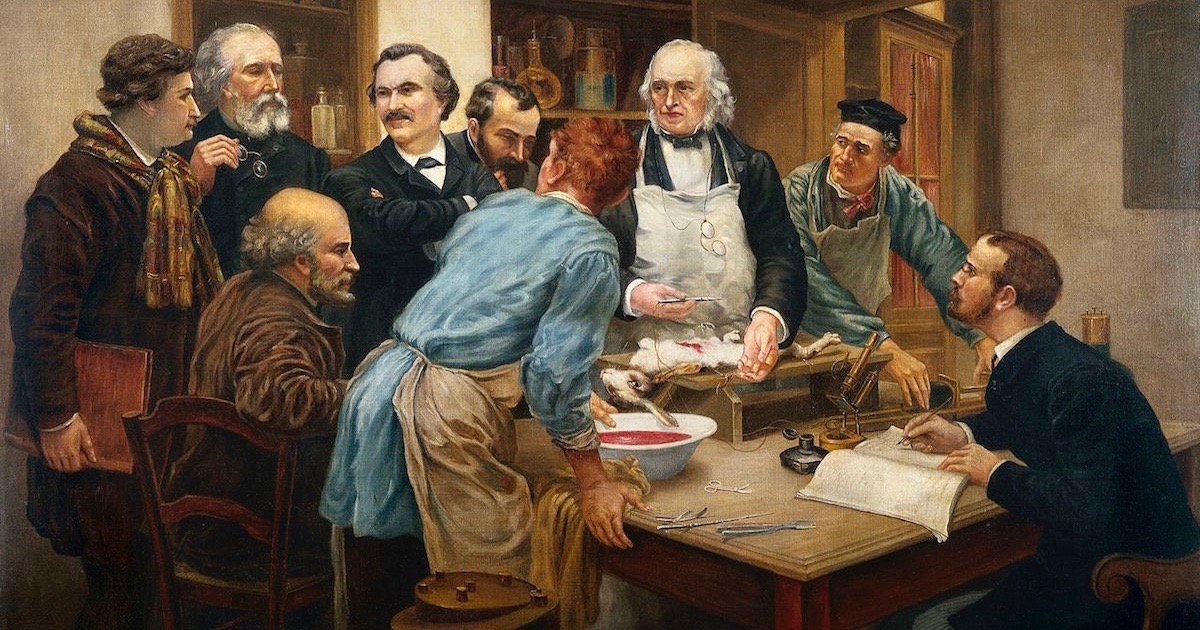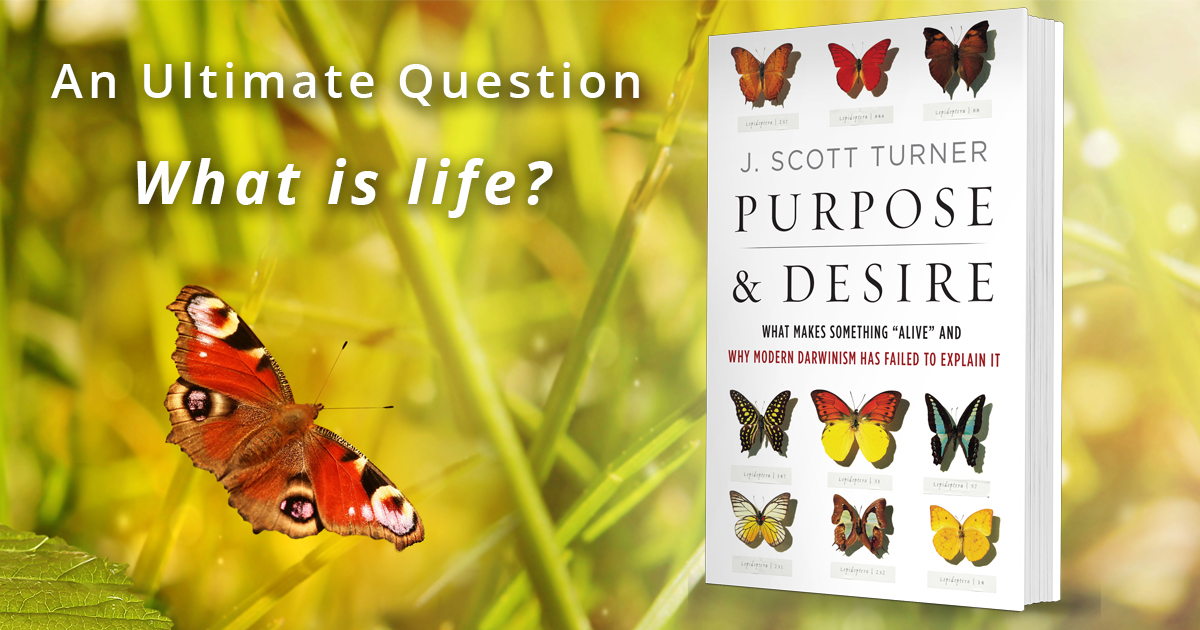 Intelligent Design
Intelligent Design
In Purpose & Desire, Out Today, Scott Turner Explores Biology’s Second Law


Claude Bernard (1813-1878) was a French physiologist, one of the most famous scientists of his age, so famous that he appeared in poems, novels, and memoirs of the period both in France and abroad. Think Albert Einstein. Even Emile Zola contemplated basing a novel on his rather unfortunate married life.
Bernard is regarded as the founder of modern physiology. His fame during his life was for his work on the pancreas, the liver, and the nervous system. He was one of the first to use experimental method in medicine. In fact, his use of vivisection is what led to the aforementioned difficulties in his marriage — his wife actively campaigned against him.
Now, however, he is most famous for his idea that the miliéu interieur, or internal environment of living things, must remain constant to sustain and maintain life. This idea is given the name homeostasis, defined as a “self-regulating process by which biological systems tend to maintain stability while adjusting to conditions that are optimal for survival. If homeostasis is successful, life continues; if unsuccessful, disaster or death ensues.”
Bernard said:
The fixity of the [interior] milieu supposes a perfection of the organism such that the external variations are at each instant compensated for and equilibrated…. All of the vital mechanisms, however varied they may be, have always one goal, to maintain the uniformity of the conditions of life in the internal environment…. The stability of the internal environment is the condition for the free and independent life.1 [Emphasis added.]
There are two things to note here. First, homeostasis requires a perfection of the organism so that the inner milieu remains balanced and equilibrated. Second is the absolute necessity of homeostasis for life. Bernard’s final sentence has become a sort of aphorism that summarizes much of his thinking. Life depends on the constancy of the internal environment; in fact there would be no free and independent life without it. State University of New York biologist Scott Turner explains in his new book, out today, Purpose and Desire: What Makes Something “Alive” and Why Modern Darwinism Has Failed to Explain It. Turner writes:
Bernard did not phrase his aphorism as an invitation to discover the mechanism of life. Rather, his aphorism is a statement of the nature of life. Specifically, homeostasis is not the outcome of life, it is life’s antecedent, and the question that Bernard is really inviting us to explore is more the “why” rather than the “how”…
“Why” questions can be deeply unsettling, for within them lurk subtlety and beauty, and perilous truth… So it is with homeostasis. Its operation — its “how dimension” — is mere mechanism, but its implications for the “why of life” — Bernard’s main point, after all — is deeply subversive of the comfortable assumptions about mechanistic life that presently reign…. To fully understand life in all its manifestations — its function, its evolution, its origin — we need to unpack the wonderful subtlety of homeostasis, as Bernard himself intended.
Homeostasis is life as a state of persistent dynamic disequilibrium…
Matter is flowing through the whole living organism, while the organism is “maintaining a persistent state of highly specified and complex organization.” Work has to be done to maintain this state. This “self-adjusting confluence of forces is precisely what living things do as a routine.” Turner observes, “It’s what distinguishes the living from the inanimate world…homeostasis is an exceedingly strange idea.” And it’s homeostasis that his book is about.
Homeostasis is a balancing act. The organism responds to environmental cues and adjusts its own chemistry to maintain things at a certain pH, temperature, oxygen level, salinity, ion concentration, glucose level etc. For creatures like us, none of those states are in equilibrium with the environment. Levels must be precisely balanced at a particular point suitable for life. For example, if our blood chemistry goes askew, it will kill us. You can read about the processes involved in its regulation in an article by Michael Denton, “The Place of Life and Man in Nature: Defending the Anthropocentric Thesis,” for the journal BIO-Complexity. He describes exactly how marvelous the regulation of blood chemistry is.
Why should we live in this continuous state of flux? We balance as if on a tightrope with hydrogen, oxygen, carbon, and nitrogen flowing through us. Who we are today, molecularly speaking, is not who we were yesterday or will be tomorrow. Yet we as individuals remain as singular points of balance. As Turner says, homeostasis is an exceedingly strange idea.
Yet without homeostasis there is no life.
Here’s the point. Can any neo-Darwinian process account for the existence of homeostasis? I have indicated just some of the kinds of things that must be regulated, each with its own controls. So as an example of the complex regulation required to maintain just one element, listen to this ID the Future podcast by physician Howard Glicksman. Calcium is regulated by the parathyroid gland using an intricate set of interacting systems of calcium uptake and release, primarily from the bone, but also the gut and the kidneys. And strict regulation of calcium concentration is essential for life.

When the parathyroid gland senses low levels of calcium in the blood, it releases the hormone PTH. It is counterintuitive, but osteoblasts (cells that take up calcium to build bone) have PTH receptors. These receptors stimulate osteoblasts to pump calcium ions out of the fluid surrounding the bone and into the extracellular fluid. They also produce a signaling molecule that activates osteoclasts (cells that break down bone to produce calcium).
PTH also stimulates calcium reabsorption in the kidney and the production of 1,25(OH)2D, the active form of vitamin D by the kidney. In the small intestine, 1,25(OH)2D works to promote calcium absorption.
I know personally just how devastating a failure of just one part of the system can be. One of my parathyroid glands started putting out too much PTH— my calcium levels went very high — and I could barely walk down the hall. Fortunately, an astute doctor figured out what was responsible, and the offending gland was removed.
Life depends on “maintaining a persistent state of highly specified and complex organization,” according to J. Scott Turner. That state of specified and complex organization must be maintained by the interacting regulatory systems of homeostasis; these are themselves complex and specified.
Not to put too fine a point on it, but the existence of complex and specified systems is a hallmark of design. How do you build a system requiring multiple signals and receptors one step at a time when the system does not work until all are present? A receptor is no good without a signal to receive, and the signal will not be sent with a cue.
Then there is the need for an effector. The parathyroid gland senses low calcium (how?) and produces PTH. PTH travels through the blood stream to its many sites of action. If PTH is high, then receptors on osteoblasts (receptors are usually proteins) receive that signal, and in turn send another signal to osteoclasts (probably a protein), which then receive that signal and effect a change (another protein?) in order to release calcium ions to the blood stream, and restore the calcium levels to where they should be. And that is just one means of regulating calcium.
To recap, from Claude Bernard:
The fixity of the [interior] milieu supposes a perfection of the organism such that the external variations are at each instant compensated for and equilibrated…. All of the vital mechanisms, however varied they may be, have always one goal, to maintain the uniformity of the conditions of life in the internal environment…. The stability of the internal environment is the condition for the free and independent life.
Scott Turner:
So it is with homeostasis. Its operation — its “how dimension” — is mere mechanism, but its implications for the “why of life” — Bernard’s main point, after all — is deeply subversive of the comfortable assumptions about mechanistic life that presently reign…. To fully understand life in all its manifestations — its function, its evolution, its origin — we need to unpack the wonderful subtlety of homeostasis, as Bernard himself intended.
Turner calls homeostasis biology’s second law. In case you were wondering, evolution by natural selection is biology’s first law. Maybe natural selection should be demoted.
Notes:
1) Bernard, C. (1974) Lectures on the phenomena common to animals and plants. Trans Hoff HE, Guillemin R, Guillemin L, Springfield (IL): Charles C Thomas.
Image: Claude Bernard and his students, via Wikicommons.
